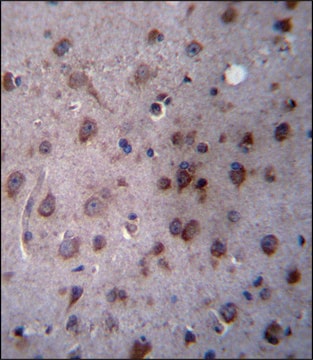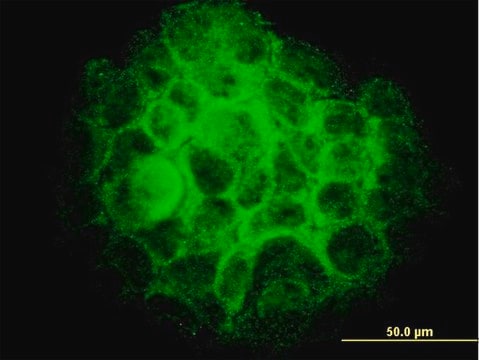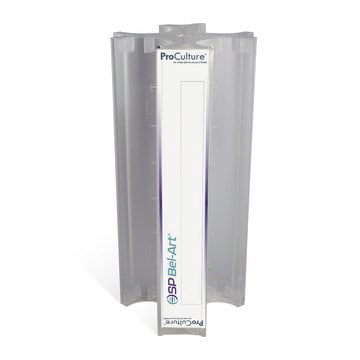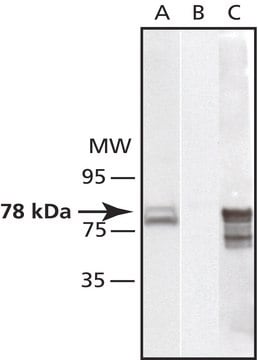推荐产品
生物源
rabbit
共軛
unconjugated
抗體表格
affinity isolated antibody
抗體產品種類
primary antibodies
無性繁殖
polyclonal
產品線
Prestige Antibodies® Powered by Atlas Antibodies
形狀
buffered aqueous glycerol solution
物種活性
human, rat, mouse
技術
immunoblotting: 0.04-0.4 μg/mL
immunofluorescence: 0.25-2 μg/mL
immunohistochemistry: 1:20-1:50
免疫原序列
DAHAEECFFERVTSGTKMGLIFEVAEGGFLDIDVEITGPDNKGIYKGDRESSGKYTFAAHMDGTYKFCFSNRMSTMTPKIVMFTIDIGEAPKGQDMETEAHQNKLEEMINELAVAMTAVKHEQEY
UniProt登錄號
運輸包裝
wet ice
儲存溫度
−20°C
目標翻譯後修改
unmodified
基因資訊
human ... TMED2(10959)
一般說明
The gene TMED2 (transmembrane p24 trafficking protein 2) encodes a member of the transmembrane emp24 domain family of proteins that are involved in the transport of polypeptides from the endoplasmic reticulum and the Golgi. It is found to be expressed in syncytiotrophoblast, cytotrophoblast, and stromal cells in the human placenta. The gene is localized to human chromosome 12q24.31.
免疫原
Transmembrane emp24 domain-containing protein 2 precursor recombinant protein epitope signature tag (PrEST)
應用
All Prestige Antibodies Powered by Atlas Antibodies are developed and validated by the Human Protein Atlas (HPA) project and as a result, are supported by the most extensive characterization in the industry.
The Human Protein Atlas project can be subdivided into three efforts: Human Tissue Atlas, Cancer Atlas, and Human Cell Atlas. The antibodies that have been generated in support of the Tissue and Cancer Atlas projects have been tested by immunohistochemistry against hundreds of normal and disease tissues and through the recent efforts of the Human Cell Atlas project, many have been characterized by immunofluorescence to map the human proteome not only at the tissue level but now at the subcellular level. These images and the collection of this vast data set can be viewed on the Human Protein Atlas (HPA) site by clicking on the Image Gallery link. We also provide Prestige Antibodies® protocols and other useful information.
The Human Protein Atlas project can be subdivided into three efforts: Human Tissue Atlas, Cancer Atlas, and Human Cell Atlas. The antibodies that have been generated in support of the Tissue and Cancer Atlas projects have been tested by immunohistochemistry against hundreds of normal and disease tissues and through the recent efforts of the Human Cell Atlas project, many have been characterized by immunofluorescence to map the human proteome not only at the tissue level but now at the subcellular level. These images and the collection of this vast data set can be viewed on the Human Protein Atlas (HPA) site by clicking on the Image Gallery link. We also provide Prestige Antibodies® protocols and other useful information.
生化/生理作用
The gene TMED2 (transmembrane p24 trafficking protein 2) encodes a type I transmembrane protein that is present in the Golgi apparatus. The N-terminal, also called the GOLD (Golgi dynamics) domain, of this protein interacts with the second extracellular loop of PAR-2 (Protease-activated receptor-2) and regulates its resensitization by influencing receptor trafficking. It participates in the maturation of calcium sensing receptor (CaSR) and prevents its degradation in the early secretory pathway.
特點和優勢
Prestige Antibodies® are highly characterized and extensively validated antibodies with the added benefit of all available characterization data for each target being accessible via the Human Protein Atlas portal linked just below the product name at the top of this page. The uniqueness and low cross-reactivity of the Prestige Antibodies® to other proteins are due to a thorough selection of antigen regions, affinity purification, and stringent selection. Prestige antigen controls are available for every corresponding Prestige Antibody and can be found in the linkage section.
Every Prestige Antibody is tested in the following ways:
Every Prestige Antibody is tested in the following ways:
- IHC tissue array of 44 normal human tissues and 20 of the most common cancer type tissues.
- Protein array of 364 human recombinant protein fragments.
聯結
Corresponding Antigen APREST72826
外觀
Solution in phosphate-buffered saline, pH 7.2, containing 40% glycerol and 0.02% sodium azide
法律資訊
Prestige Antibodies is a registered trademark of Merck KGaA, Darmstadt, Germany
免責聲明
Unless otherwise stated in our catalog or other company documentation accompanying the product(s), our products are intended for research use only and are not to be used for any other purpose, which includes but is not limited to, unauthorized commercial uses, in vitro diagnostic uses, ex vivo or in vivo therapeutic uses or any type of consumption or application to humans or animals.
Not finding the right product?
Try our 产品选型工具.
儲存類別代碼
10 - Combustible liquids
水污染物質分類(WGK)
WGK 1
閃點(°F)
Not applicable
閃點(°C)
Not applicable
個人防護裝備
Eyeshields, Gloves, multi-purpose combination respirator cartridge (US)
Fortunato Morabito et al.
British journal of haematology, 146(1), 44-53 (2009-05-15)
IGHV mutational status and ZAP-70 or CD38 expression correlate with clinical course in B-cell chronic lymphocytic leukaemia (CLL). The three markers may be discordant in the single case and there is no consensus on their combined use in clinical practise.
Weibo Luo et al.
The Journal of biological chemistry, 282(41), 30246-30255 (2007-08-19)
Protease-activated receptor-2 (PAR-2), the second member of the G protein-coupled PAR family, is irreversibly activated by trypsin or tryptase and then targeted to lysosomes for degradation. Intracellular presynthesized receptors stored at the Golgi apparatus repopulate the cell surface after trypsin
Ann Stepanchick et al.
Biochemical and biophysical research communications, 395(1), 136-140 (2010-04-07)
The calcium sensing receptor (CaSR) is a Family 3/C G protein-coupled receptor with slow and partial targeting to the plasma membrane in both native and heterologous cells. We identified cargo receptor family member p24A in yeast two-hybrid screens with the
A Zakariyah et al.
Placenta, 33(3), 214-219 (2012-01-04)
Members of the transmembrane emp24 domain (Tmed)/p24 family of proteins are required for transport of proteins between the endoplasmic reticulum and the Golgi. One member of this family, Tmed2/p24β1, is expressed during placental development in mice and its expression is
Gong Shi-Peng et al.
Oncotarget, 8(55), 94151-94165 (2017-12-08)
TMED2 is involved in morphogenesis of the mouse embryo and placenta. We found that expression of TMED2 was higher in epithelial ovarian cancer tissues than normal ovarian tissues. Silencing TMED2 decreased cell proliferation, migration, and invasion. Ectopic expression of TMED2
我们的科学家团队拥有各种研究领域经验,包括生命科学、材料科学、化学合成、色谱、分析及许多其他领域.
联系技术服务部门








